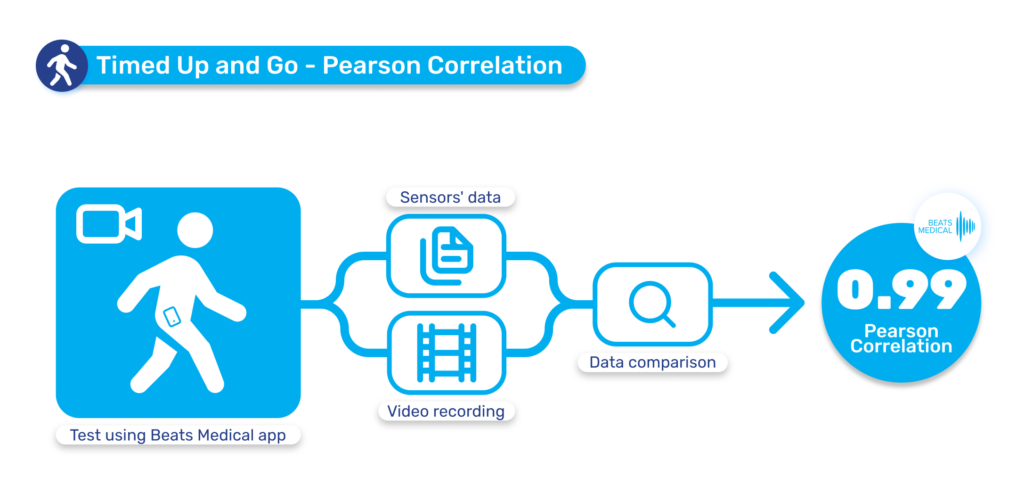A Novel Approach for Measuring Mobility Changes
The cost of bringing a new drug to market is doubling approximately every 9 years [1]. However, this doesn’t mean we’re becoming less efficient with drug development. Several factors are contributing to this:
a – Clinical trials are increasing in size and complexity, while drug regulations have become more stringent.
b – Drugs must objectively outperform their predecessors. Complex diseases like Parkinson’s, Alzheimer’s or Rare Diseases require a greater allocation of resources, with higher levels of uncertainty.
c – Our understanding of multifactorial diseases remains incomplete. Addressing these challenges requires the adoption of new methods and practices that may lead to breakthroughs and pave the way for a better life for individuals living with these conditions.
At Beats Medical, we can support our partners to pave the way for improved outcomes for individuals. Our platform provides a variety of precision digital assessments and individualised digital therapies from four distinct modules: Gross Motor, Fine Motor, Speech and Wellbeing. Our investments in developing innovative technological methods have been recognised over the past 8 years. Using commercial mobile technology in the context of clinical trials is growing and has the potential to revolutionise the landscape of new discoveries, making the process faster, frictionless, and more cost-effective for companies. On the other hand, participants can rapidly connect without disrupting their daily lives, consequently reducing the problem of high dropout rates.
Timed Up and Go: An Established Approach for Measuring Mobility Changes
The Timed Up and Go (TUG) is a widely recognised clinical assessment tool used to evaluate mobility and balance in older adults or individuals with mobility impairments. This assessment is adopted as an endpoint in several clinical trials. It involves measuring the time it takes for an individual to stand up from a chair with armrests, walk 3 meters (10 feet), turn around, walk back, and sit down again. The TUG test provides valuable information about functional mobility, fall risk, and changes in mobility over time [2]. Traditionally, it is conducted in a clinical or healthcare setting, with a healthcare professional instructing the individual to perform the task as quickly and safely as possible. The time taken to complete the test is recorded for assessment purposes.
Beats Medical: Digitising the TUG Test
Under our gross motor module, we have made a breakthrough in how we deliver the TUG test. A digital TUG eliminates the necessity for a physical setup, while offering more precise measurements of movement, balance and gait parameters. This diminishes the dependence on subjective observations and enhances the accuracy of assessments, leading to a deeper comprehension of conditions affecting individuals with impaired mobility.
At Beats Medical, we recognised the potential of a digitised Timed Up and Go early on and developed an algorithm that captures measurements from mobile phone sensors across Apple and Android’s technology, with no additional hardware or sensors required.
During a TUG, the user is instructed by their phone to set up a chair with armrests against a wall, measure a distance of 3 meters (10 feet) from the chair, and place the phone in their pocket to initiate the assessment. Subsequently, the user receives audio instructions to guide them through the several Timed Up and Go stages in a standardised manner:
- Sit-to-stand
- Walk-out
- Turn-around
- Walk-in
- Stand-to-sit
Demonstrating the Robustness and Adaptability of our Technology
In one experiment involving healthy subjects, we conducted tests using both Android and iOS devices. Each subject consistently placed the device in the same pocket for standardised conditions and was video recorded for further analysis by our research team. When comparing the total duration from stage 1 (sit-to-stand) to stage 5 (stand-to-sit) with the video recordings, the TUG algorithm demonstrated a Pearson correlation of 0.96, harmonised between both iOS and Android platforms (Pearson correlations range from –1, indicating completely opposite datasets, to +1, indicating identical datasets).
Another experiment involved individuals with Parkinson’s disease, between Hoehn and Yahr stages I-III and in their on-time, where medication is working and symptoms are controlled. Multiple TUG tests were conducted, following the exact approach outlined in the previous experiment. The TUG algorithm demonstrated a Pearson correlation of 0.99, harmonised between both iOS and Android platforms.
The results of both experiments were conclusive, demonstrating the robustness and adaptability of our technology across various scenarios, ranging from healthy individuals to those who experience mobility impairments due to a CNS condition. This adaptability allows our partners to adopt such a solution to address the specific needs of studies and clinical trials.
Read more about how we partner with leading pharmaceutical companies here.

Timed Up and Go: An Assessment for Measuring Mobility Changes
Beats Medical’s digitised Timed Up and Go offers valuable insights into gait patterns and potential digital biomarkers, laying the foundation for surpassing traditional tests in terms of accuracy, convenience, and cost-effectiveness with commercial mobile technology. Individuals can now comfortably conduct this test from their homes while experiencing a sense of engagement, trust and support, thereby furnishing researchers with detailed insights into their distinct mobility challenges.
The TUG test has proven to be an applicable research tool in populations such as those with Parkinson’s disease, Multiple Sclerosis, hip fractures, Alzheimer’s disease, cerebrovascular accidents (CVA), total knee replacements (TKR), total hip replacements (THR), and Huntington’s disease. A study published in 2022 revealed that the TUG test can even serve as a robust predictor of mortality, outperforming established risk factors, including chronic diseases, in low- and middle-income geriatric populations [3].
Similar to the 2MWT, there are currently no other commercially available mobile solutions capable of providing a comprehensive and detailed analysis of gait changes throughout the TUG test’s five stages. This underscores the potential of Beats Medical’s digital TUG as a “lens” for companies to gain a better understanding of complex and multifactorial conditions, ultimately paving the way for improving the lives of individuals who experience mobility impairments.
We invite you to join us on this exciting journey as we redefine the future of clinical trials and work together to improve patient outcomes in CNS and rare conditions.
For more information about how we can support your clinical trial pipeline visit our Partners page below, or reach out to andrew@beatsmedical.com.
References
[1] Scannell, J., Blanckley, A., Boldon, H. et al. Diagnosing the decline in pharmaceutical R&D efficiency. Nat Rev Drug Discov 11, 191–200 (2012). https://doi.org/10.1038/nrd3681
[2] Shumway-Cook A, Brauer S, Woollacott M. Predicting the probability for falls in community-dwelling older adults using the Timed Up & Go Test. Physical therapy. 2000 Sep 1;80(9):896-903.Available from:https://academic.oup.com/ptj/article/80/9/896/2842520
[3] Ascencio EJ, Cieza-Gómez GD, Carrillo-Larco RM, Ortiz PJ. Timed up and go test predicts mortality in older adults in Peru: a population-based cohort study. BMC geriatrics. 2022 Dec;22(1):1-3.


